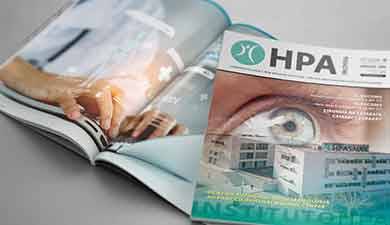Enf.ª Patrícia Sancho
Specialist in Maternal
and Obstetric Health
Head of Nursing Services Gynaecology/Obstetrics Unit
Doctorate in Educational Sciences

A golden hour
The 1st hour after childbirth
HPA Magazine 16
The “golden hour” is defined as the first hour of life after birth. The concept of Golden Hour did not originate in Obstetrics, but in an Emergency concept.
During the first 60 minutes of life, the Obstetric Team adopts practices aimed at respecting the mother’s wishes (expressed in her Birth Plan), safety and comfort for her baby, safe and recommended practices, offering the best possible beginning of life for her baby.
One of the recommendations is the possibility of skin-to-skin contact for the mother and baby soon after birth and whenever they wish, during the entire hospital stay. This practice is one of the recommendations for humanization of childbirth, providing a more positive childbirth experience, considered a strong recommendation by the World Health Organization.
Did you know that your baby goes through nine stages in the first hour of life? The nurse who will accompany the new mother during this first hour will help her recognize these steps.

There are countless benefits for this practice, which includes influencing the baby's microbiome, strengthening the immune system.
It promotes adaptation to extrauterine life, supporting a more physiological transition, aids cardiorespiratory stabilization, helps to prevent hypothermia (stabilizing the baby's body temperature), also promotes blood glucose stabilization, reduces stress and favours sleep and relaxation for both mother and infant.
It is also essential for bonding purposes. The only environment after birth that babies are adapted to, is the mother's body. The closeness that is created with skin to skin contact is fundamental for the bonding process, and is one of the reasons why the team favours this moment, offering the mother the opportunity to warm up, feel and get to know each other.
Studies argue that this practice increases maternal oxytocin production, reducing stress and the risk of bleeding after childbirth. It is also a protective factor for the mother's mental health, reducing postpartum depression.
There may be certain conditions however, where this practice may have to be postponed, due to after delivery clinical condition of mother-infant. However, as soon as possible, the nursing team will support and recommend that breastfeeding should begin, due to the numerous advantages it offers.
After delivery and throughout the hospital stay, the team will support the mother in the task of breastfeeding, according to the recommendations of Maternity(1) Safe Care.
Therefore, we recommend that during skin-to-skin contact the baby's head is kept in a neutral position; the head should be turned sideways keeping the mouth and nose free, the baby's shoulders and chest should be placed over the mother's chest with the legs bent. The baby's back should be covered with a blanket to maintain the skin surface that is not in contact with the mother's body, warm.
IMPACT ON BREASTFEEDING
This practice is considered a protective factor for breastfeeding, as it improves the rate of exclusive breastfeeding by 50%; it promotes a more organized breastfeeding pattern, increases the baby's readiness to breastfeed and offers the mother the possibility to recognize her baby's first signs of hunger.
It also helps to reduce the risk of breast complications, which are very common during the first few days, such as breast engorgement.
The Obstetrics Team will continue to teach and supervise to ensure that both mother and baby can comfortably and safely enjoy this practice. Ask your Obstetrician or Specialist Nurse in Maternal Health for more information during your Obstetrics Appointments and take the opportunity to discuss your Birth Plan with our Team. You can confirm our Birth Plan on:
https://www.grupohpa.com/uploads/files/Plano_de_parto.pdf









